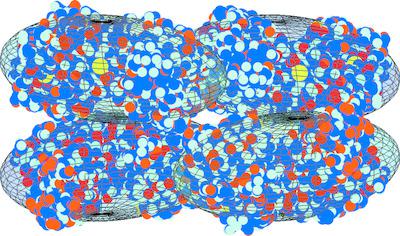当前位置:
X-MOL 学术
›
Acta Crystallogr. A Found. Adv.
›
论文详情
Our official English website, www.x-mol.net, welcomes your
feedback! (Note: you will need to create a separate account there.)
Mathematical aspects of molecular replacement. V. Isolating feasible regions in motion spaces.
Acta Crystallographica Section A: Foundations and Advances ( IF 1.9 ) Pub Date : 2020-02-05 , DOI: 10.1107/s2053273319014797 Bernard Shiffman 1 , Shengnan Lyu 2 , Gregory S Chirikjian 3
Acta Crystallographica Section A: Foundations and Advances ( IF 1.9 ) Pub Date : 2020-02-05 , DOI: 10.1107/s2053273319014797 Bernard Shiffman 1 , Shengnan Lyu 2 , Gregory S Chirikjian 3
Affiliation

|
This paper mathematically characterizes the tiny feasible regions within the vast 6D rotation-translation space in a full molecular replacement (MR) search. The capability to a priori isolate such regions is potentially important for enhancing robustness and efficiency in computational phasing in macromolecular crystallography (MX). The previous four papers in this series have concentrated on the properties of the full configuration space of rigid bodies that move relative to each other with crystallographic symmetry constraints. In particular, it was shown that the configuration space of interest in this problem is the right-coset space Γ\G, where Γ is the space group of the chiral macromolecular crystal and G is the group of rigid-body motions, and that fundamental domains FΓ\G can be realized in many ways that have interesting algebraic and geometric properties. The cost function in MR methods can be viewed as a function on these fundamental domains. This, the fifth and final paper in this series, articulates the constraints that bodies packed with crystallographic symmetry must obey. It is shown that these constraints define a thin feasible set inside a motion space and that they fall into two categories: (i) the bodies must not interpenetrate, thereby excluding so-called `collision zones' from consideration in MR searches; (ii) the bodies must be in contact with a sufficient number of neighbors so as to form a rigid network leading to a physically realizable crystal. In this paper, these constraints are applied using ellipsoidal proxies for proteins to bound the feasible regions. It is shown that the volume of these feasible regions is small relative to the total volume of the motion space, which justifies the use of ellipsoids as proxies for complex proteins in MR searches, and this is demonstrated with P1 (the simplest space group) and with P212121 (the most common space group in MX).
中文翻译:

分子置换的数学方面。五,隔离运动空间中的可行区域。
本文在数学上对全分子置换(MR)搜索中6D旋转-平移空间中微小的可行区域进行了表征。先验隔离此类区域的能力对于增强大分子晶体学(MX)的计算定相中的鲁棒性和效率潜在重要。该系列的前四篇论文集中于刚体的完整配置空间的特性,这些刚体在具有晶体对称性约束的情况下相对移动。特别是,已经表明,该问题中感兴趣的构型空间是右陪集空间Γ\ G,其中Γ是手性高分子晶体的空间群,G是刚体运动的群,并且基本域FΓ\ G可以用具有有趣的代数和几何特性的许多方式实现。MR方法中的成本函数可以看作是这些基本域上的函数。这是本系列的第五篇也是最后一篇文章,阐明了晶体对称包装的主体必须遵守的约束。结果表明,这些约束在运动空间内定义了一个薄的可行集,它们分为两类:(i)物体不得相互渗透,从而在MR搜索中不考虑所谓的“碰撞区”;(ii)物体必须与足够多的邻居接触,以形成导致可物理实现晶体的刚性网络。在本文中,这些限制条件是使用椭球代理对蛋白质进行约束的区域。
更新日期:2020-02-05
中文翻译:

分子置换的数学方面。五,隔离运动空间中的可行区域。
本文在数学上对全分子置换(MR)搜索中6D旋转-平移空间中微小的可行区域进行了表征。先验隔离此类区域的能力对于增强大分子晶体学(MX)的计算定相中的鲁棒性和效率潜在重要。该系列的前四篇论文集中于刚体的完整配置空间的特性,这些刚体在具有晶体对称性约束的情况下相对移动。特别是,已经表明,该问题中感兴趣的构型空间是右陪集空间Γ\ G,其中Γ是手性高分子晶体的空间群,G是刚体运动的群,并且基本域FΓ\ G可以用具有有趣的代数和几何特性的许多方式实现。MR方法中的成本函数可以看作是这些基本域上的函数。这是本系列的第五篇也是最后一篇文章,阐明了晶体对称包装的主体必须遵守的约束。结果表明,这些约束在运动空间内定义了一个薄的可行集,它们分为两类:(i)物体不得相互渗透,从而在MR搜索中不考虑所谓的“碰撞区”;(ii)物体必须与足够多的邻居接触,以形成导致可物理实现晶体的刚性网络。在本文中,这些限制条件是使用椭球代理对蛋白质进行约束的区域。











































 京公网安备 11010802027423号
京公网安备 11010802027423号